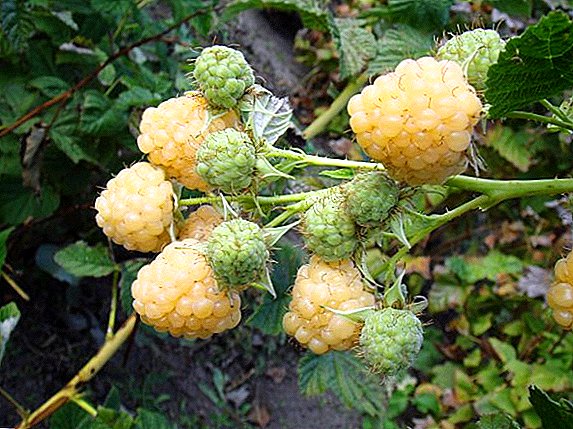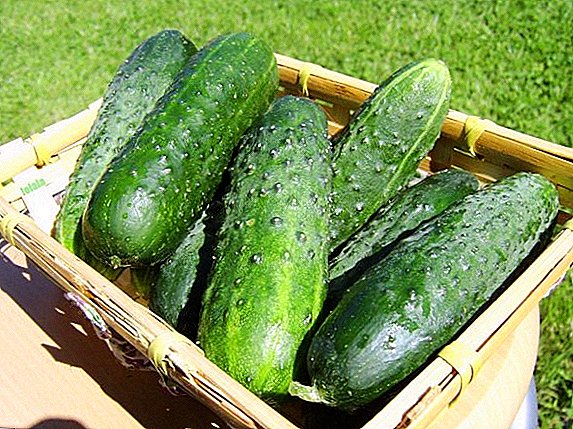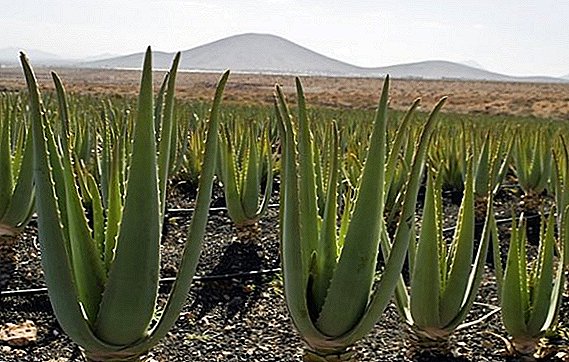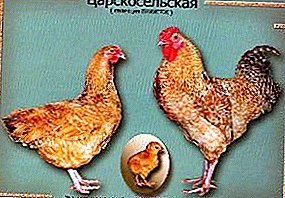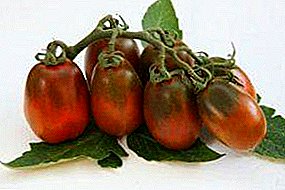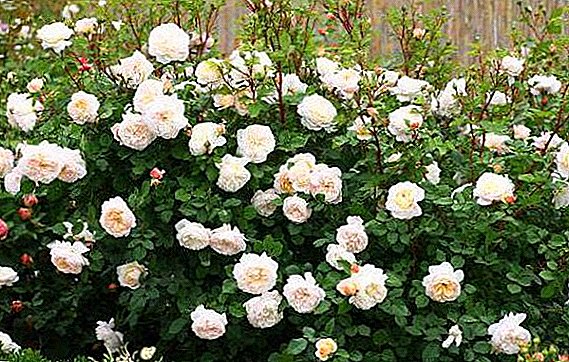 Rose - one of the most beautiful flowers. Despite the fact that its history is very ancient, it is still popular. And in this the merit of breeders. These specialists are constantly working hard to create new, unusual varieties that will delight and amaze gardeners. One such specialist is David Austin. About his creation called "Crocus Rose" will be discussed in this article.
Rose - one of the most beautiful flowers. Despite the fact that its history is very ancient, it is still popular. And in this the merit of breeders. These specialists are constantly working hard to create new, unusual varieties that will delight and amaze gardeners. One such specialist is David Austin. About his creation called "Crocus Rose" will be discussed in this article.
History of the variety
The British breeder was delighted with the rich and unique aromas of vintage garden roses. Unfortunately, these flowers were quite sensitive to weather conditions and unstable to pests.
And Austin set himself the task of bringing out new, more sustainable varieties. So in 2000 appeared the variety of roses "Crocus Rose". The flower was obtained from the all-beloved "Golden Celebration".  The popularity of the new flower instantly went beyond the limits of Britain. He has new names: "Emmanuel", "City of Timaru", "Ausquest". And our gardeners prefer to call the flower a crocus rose.
The popularity of the new flower instantly went beyond the limits of Britain. He has new names: "Emmanuel", "City of Timaru", "Ausquest". And our gardeners prefer to call the flower a crocus rose.
Features
Rose "Crocus Rose" refers to the English roses. Therefore, it is characterized by all the features of this group:
- frost resistance;
- resistance to many diseases;
- aroma saturation;
- flowering splendor;
- decorative
English roses also include: Benjamin Britten's rose, David Austin's rose, Abraham Derby's rose, Mary Rose's rose, Rose of Sins Thomas, Rose of William Shakespeare and Rose of Falstaff.
She also has individual characteristics:
- resistance to increased moisture;
- variability of bud color depending on the stage of flowering;
- high resistance to black spot and slightly worse to powdery mildew;
- strong aroma of tea rose;
- violent bloom.
Description
"Crocus Rose" - semi-rose (class Shrub). It reaches 120 centimeters in height, and no more than 90 centimeters in width. Semiglossy foliage, deep dark green.  Initially, the breeder wanted to attribute his new creation to white varieties. But the white color of the bud appears in the final stage of flowering. While the bud has not opened, it is painted in peach or apricot tones. Gradually revealing, he loses color and becomes white. Only the core retains the same shade.
Initially, the breeder wanted to attribute his new creation to white varieties. But the white color of the bud appears in the final stage of flowering. While the bud has not opened, it is painted in peach or apricot tones. Gradually revealing, he loses color and becomes white. Only the core retains the same shade.
Did you know? The registration name of this variety of roses was "Ausquest". The current name of the flower received from the fund "The Crocus Trust", specializing in helping cancer patients.
The flower is small, not more than 8 centimeters in diameter, strongly double-lined. Forms brushes, because of what the bush is evenly covered with flowers. Exudes a rich, but not sharp aroma of tea roses. Blossoms almost continuously.
Common flower names: "Emmanuel", "City of Timaru", white (peach, apricot) ostinka.
Landing
In order for a plant to grow and develop normally, it is necessary to know some subtleties in its planting.
Location
"Crocus Rose" - light-loving flower. He needs to get sunlight at least six hours a day. But he does not like strong heat. Therefore, it is best to plant it in the eastern or western part of the site.
Important! It should not be planted "Crocus Rose" in the lowlands, where the air stagnates. For normal growth, it needs good air circulation, but not a draft.
Also, there should be no trees nearby (within a radius of two meters) and other bushes (within a radius of a meter), since the weaker root system of the flower cannot resist the growth of a strong one. And the rose will not be able to receive nutrients in abundance.  When choosing a place you need to take into account the presence of groundwater. If they are closer to the surface than one meter, then it is not suitable for roses. She will wither in her eyes.
When choosing a place you need to take into account the presence of groundwater. If they are closer to the surface than one meter, then it is not suitable for roses. She will wither in her eyes.
The soil
The best soil for a flower is black soil or loamy soil. The soil should be moderately acidic (pH 6-6.5). If the acidity is low, then add manure or peat to the ground. To reduce the acidity, use wood ash.
When preparing the pit for planting, pour compost and humus into it. If you do not have these components at hand, you can pour fertilizer. When planting a seedling, its roots should be 5-6 centimeters above the fertilizer layer.
Read also about the peculiarities of cultivation: groundcover, Dutch, park, Canadian, spray, climbing and standard roses.
Planting plant
Alone planting a rose bush is not very convenient. Assistant needed.
Prepare the pit first. It is excavated with a depth of 70 centimeters. Expanded clay or other drainage is laid on the bottom. Sprinkle with fertilizer on top. The thickness of the drainage layer and the fertilizer layer should be approximately the same. For fertilizer lay out a special soil for roses.
When the pit is ready, prepare the seedling. Its roots fall into the ground, diluted with water, for 10-20 minutes. Then we plant a bush in a hole. Deepen it should be so that the vaccine was hidden under 7-8 centimeters of soil. At the time of sleeping poles seedling must be kept exactly.  After planting we pour abundantly. If the earth is heavily settled, then we are getting enough sleep.
After planting we pour abundantly. If the earth is heavily settled, then we are getting enough sleep.
It is better to plant in spring, so that the plant is stronger by winter.
Important! The first month after planting the bush needs regular watering (once or twice for 7 days). You need to pour a bucket of water under the flower. If a drought has arrived, the frequency of watering should be increased to two or three times for 7 days and poured into a bush for a half or two buckets.
Care
For intensive growth and abundant flowering roses need proper care.
Watering
Variety "Crocus Rose" is resistant to moisture, but it concerns rain. Watering should be moderate. With excessive moisture, the stems begin to dry out. Optimally water the plant every 7 days. In the dry and hot season - once every 3-4 days. 
Top dressing
Feeding is carried out once a season. In the spring they make nitrogenous fertilizers, in the summer - potash-phosphorus fertilizers. Experts recommend using special fertilizers for roses.
For example, "ASB Greenworld". Differs in duration of action. It is used every three months. One pack can feed 100 bushes.
Did you know? The ancient Romans were the first to start growing roses, although for their gardens it was unacceptable to breed ornamental plants.
Pruning
On young bushes in the first year of their life should be pruned flowers until August. This is necessary so that the flower is well rooted. In the fall, you need to leave a few flowers, so that the rose blooms well next year.
Adult bushes pruned regularly in spring and autumn. With the advent of the first buds, you need to cut off the dead stalks and give the bush the desired shape. In the fall, diseased shoots are removed so that the disease does not spread over the winter to the whole bush. 
Wintering
"Crocus Rose" refers to frost-resistant flowers. But if in your region the temperature falls below seven degrees of frost, then it is better to cover the plant. This should be done as follows. First, spud the roots and sprinkle with dry foliage or sawdust. You can cover the fir branches. After around the bush from the wire frame is formed.
Read more about the choice of covering material and how to hide roses for the winter.
It should be 20-30 centimeters taller than the plant. The frame is covered with mulch fabric or special insulation. Over it lined with a layer of film. In early March-April, we gradually turn off the insulation so that the rose gets used to temperature changes.
Diseases and pests
This variety of roses has a high resistance to diseases and pests. Average resistance to it only to powdery mildew. This is a fungal disease that affects the leaves, shoots, buds.
Manifested in the form of white bloom. After spore ripening, droplets of liquid appear. The disease rises from the ground.  If the rose is severely affected, then the diseased leaves and buds start to curl and fall off. Shoots bend and stop growing. The disease appears after heavy rains in the summer.
If the rose is severely affected, then the diseased leaves and buds start to curl and fall off. Shoots bend and stop growing. The disease appears after heavy rains in the summer.
To get rid of the misfortune, you need to cut off all the diseased parts of the plant and burn them. The affected bush should be sprayed with colloidal sulfur or "Tiovit Jet", "Fitosporin-M", "Fundazole", and copper sulfate.
It will be useful for you to learn how to get rid of powdery mildew on a rose.
As a prevention, use a decoction of horsetail or infusion of nettle. They should spray bush.
Many gardeners consider the rose "Crocus Rose" to be a capricious flower. But if you analyze the features of care, it is clear that she does not require any special attention to herself.
Subject to all the rules, the bush will not bring more trouble than a normal cultivated plant.



